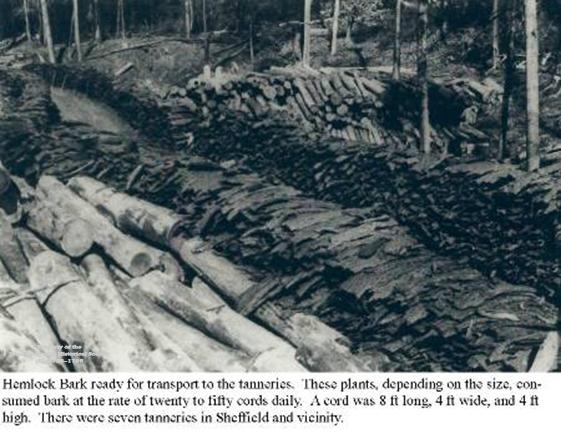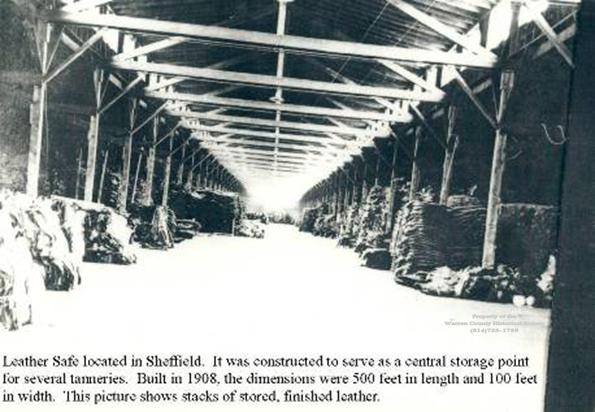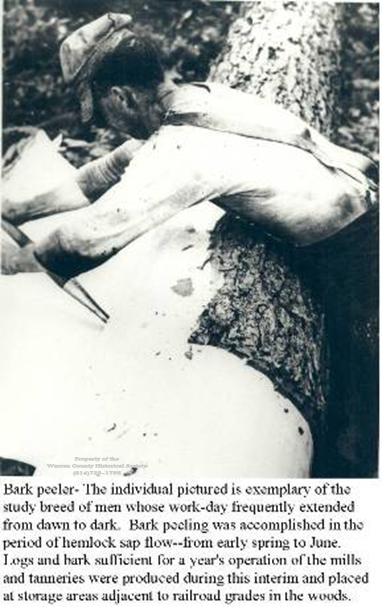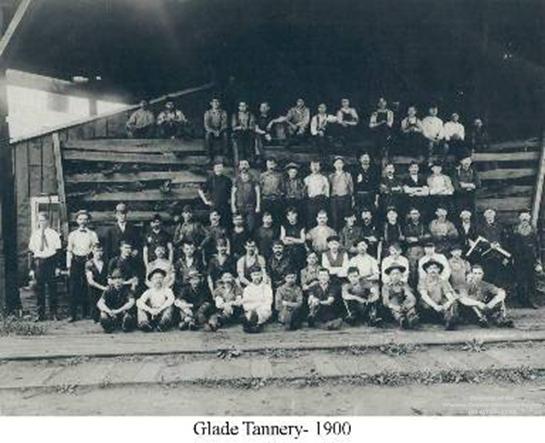
Tanning Leather
Around 1850, White Pines became scarce because so many of the trees were being cut down. Then Hemlock trees were being cut for the bark. The bark was used to turn animal hides into leather. This is called tanning.
Water, hides, and tannic acid are the main ingredients needed for tanning. Tannic acid is found in the bark of some trees. Hemlock trees were the greatest source of tannic acid in Warren County.
Tanneries were found mostly in the southeast part of the county along the Tionesta Creek.
Webb and Walter Horton, tanning industrialists, came to the Sheffield wilderness in 1864 and immediately began purchasing hemlock forest land. There were six tanneries within the Sheffield area, which led to the destruction of area forests.
Hemlock tree lumber was not durable. After stripping the trees of bark, the logs were left on the ground. This was called "slash-cutting."
Bark was usually peeled from the middle of May until the end of July, depending on how wet or dry the season was. After July, the bark would tighten and be close to impossible to peel off the trees.
Bark was peeled by a five-man crew. Two men worked a crosscut saw, cutting logs. One man fitted the bark, marking lengths of the tree. One man peeled the bark, called "spudding." The fifth man turned the log and made the tree's knots level with the tree.
Transportation of bark from the woods to the tannery was at first done with horse-drawn wagons. Each wagon was fitted with a sort of cradle made of stakes. The stakes fitted into the holes in the bottom of the wagon bed. Later, these were made into railroad cars.
At a tannery, the bark was built up to form a roof on which the final layer of slabs was placed in the manner of shingles to provide rain run-off. 
After the hides arrived at the tannery, they were left to soak in water pits for a few days to soften the hides. Then the hides would be split down the back to separate them into sides. After soaking in a lime and water mixture, hair was taken off the hide by hand using a tool like a blunt knife.
To actually tan the hides, the hides were dipped in a lye mixture until they became pale in color. After a day or two, the hides were put into vats and covered with dampened, ground-up bark. After four to five weeks, the hides would be removed from the vats.
Next, the hides would dry on a rack for a few days. An iron roller machine would roll over the dried hides to make them a uniform thickness, and a flattening board would be used to pound out thicker parts. Once uniform in thickness, the hides would be put back in to the strong bark liquor to soak, called "currying."
One leather safe was built in Sheffield in 1908. It was larger than a football field.


FAST FACTS—TANNERIES
• Three resources were essential to the tanning industry—water, acid, and animal hides.
• The Tionesta Creek provided the water for many of the Warren County tanneries.
• Hemlock trees grew in abundance in the Tionesta Creek area, providing tannic acid used for tanning hides.
• In the early days of tanneries, hemlock trees were cut, the bark was peeled, and the trees
were left to rot in the woods.
• Later, a saw mill and a tannery were part of the same business to utilize the wood and the bark.
• Tanneries lost their usefulness with the production of synthetic leather. Very few tanneries exist in the United States today.
Additional Attachments:
Tanning and the Lumber Industry
Tanbark Peelers and Knot Bumpers

Courtesy of the Warren County Historical Society